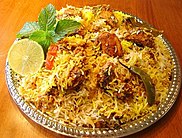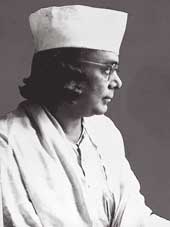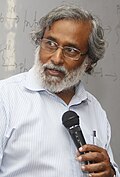Bengalis
| |
|---|---|
| Total population | |
| c. 285 million[1][2][3] | |
| Regions with significant populations | |
| 175,000,000[4][5][6] | |
| 97,228,917[7][8] | |
| 2,000,000[9] | |
| Languages | |
| Bengali and its dialects | |
| Religion | |
| |
| Related ethnic groups | |
| Indo-Aryan peoples | |
a. Spoken as the first language by a significant number of Bengalis in Pakistan, India and Old Dhaka. | |
| Part of a series on |
| Bengalis |
|---|
 |
| Part of a series on the |
| Culture of Bengal |
|---|
 |
| History |
| Cuisine |
Bengalis (
Bengalis are the
.Bengalis are a diverse group in terms of religious affiliations and practices. Today, approximately 68% are adherents of
Like every large culture group in history, Bengalis have greatly influenced and contributed to diverse fields, notably the arts and architecture, language, folklore, literature, politics, military, business, science and technology.
Etymology
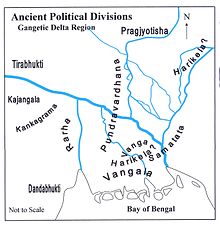
The term Bengali is generally used to refer to someone whose linguistic, cultural or ancestral origins are from
The historic land of Vaṅga (bôngô in Bengali), situated in present-day
In 1352 CE, a Muslim nobleman by the name of
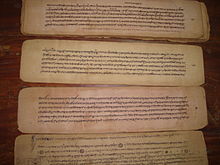
History
Ancient history

Archaeologists have discovered remnants of a 4,000-year-old
Artefacts suggest that the Chandraketugarh, which flourished in present-day North 24 Parganas, date as far back as 600 BC to 300 BC,[46] and Wari-Bateshwar civilisation, which flourished in present-day Narsingdi, date as far back as 400 BC to 100 BC.[47][48] Not far from the rivers, the port city of Wari-Bateshwar, and the riverside port city of the Chandraketugarh,[49] are believed to have been engaged in foreign trade with Ancient Rome, Southeast Asia and other regions.[49] The people of this civilisation live in bricked homes, walked on wide roads, used silver coins[50] and iron weaponry among many other things. The two cities are considered to be the oldest cities in Bengal.[51]
It is thought that a man named Vanga settled in the area around 1000 BCE founding the
One of the earliest foreign references to Bengal is the mention of a land ruled by the king Xandrammes named Gangaridai by the Greeks around 100 BCE. The word is speculated to have come from Gangahrd ('Land with the Ganges in its heart') in reference to an area in Bengal.[53] Later from the 3rd to the 6th centuries CE, the kingdom of Magadha served as the seat of the Gupta Empire.
Middle Ages
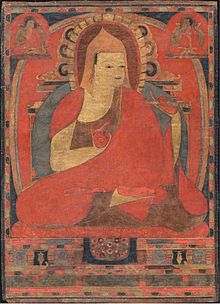
One of the first recorded independent kings of Bengal was
The Pala Empire enjoyed relations with the

The Pala dynasty was followed by a shorter reign of the

The establishment of a single united
Mughal era


The
By the early 17th century,
Mughal Bengal eventually became a quasi-independent monarchy state ruled by the

Bengal became the basis of the
British colonisation
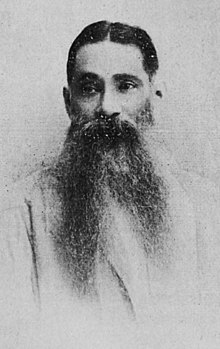
In Bengal, effective political and military power was transferred from the
Under British rule, Bengal experienced deindustrialisation.[75] Discontent with the situation, numerous rebellions and revolts were attempted by the Bengali people. The Indian Rebellion of 1857 was initiated on the outskirts of Calcutta, and spread to Dhaka, Jalpaiguri and Agartala, in solidarity with revolts in North India. Havildar Rajab Ali commanded the rebels in Chittagong as far as Sylhet and Manipur. The failure of the rebellion led to the abolishment of the Mughal court completely and direct rule by the British Raj.
Many Bengali labourers were taken as coolies to the British colonies in the Caribbean during the 1830s. Workers from Bengal were chosen because they could easily assimilate to the climate of
Independence movement
Bengal played a major role in the
Leaders such as Subhas Chandra Bose did not subscribe to the view that non-violent civil disobedience was the best way to achieve independence, and were instrumental in armed resistance against the British. Bose was the co-founder and leader of the Japanese-aligned Indian National Army (distinct from the army of British India) that challenged British forces in several parts of India. He was also the head of state of a parallel regime, the Azad Hind. A number of Bengalis died during the independence movement and many were imprisoned in the notorious Cellular Jail in the Andaman Islands.
Partitions of Bengal
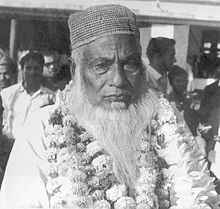
The
The breakdown of Hindu-Muslim unity in India drove the Muslim League to adopt the
Bangladesh Liberation War
The rise of
Geographic distribution

Bengalis constitute the largest ethnic group in Bangladesh, at approximately 98% of the nation's inhabitants.
Bengali ethnic descent and emigrant communities are found primarily in other parts of
The introduction of
Earliest records of Bengalis in the European continent date back to the reign of King
Language
An important and unifying characteristic of Bengalis is that most of them use Bengali as their native tongue, believed to belong to the
modern borrowings primarily come from the English language.
Various forms of the language are in use today and provide an important force for Bengali cohesion. These distinct forms can be sorted into three categories. The first is
Social stratification
This section needs additional citations for verification. (June 2022) |
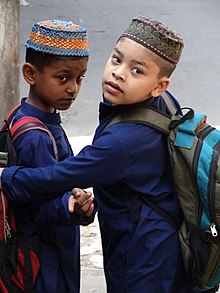
Bengali people may be broadly classified into sub-groups predominantly based on dialect but also other aspects of culture:
- Chittagong.
- Among Bangals, there are four subgroups that maintain distinct identities in addition to having a (Eastern) Bengali identity.Bengali Muslim community residing in Old Dhaka city that noticeably differ from the rest of the people of Dhaka Divisionby culture.
- Among Bangals, there are four subgroups that maintain distinct identities in addition to having a (Eastern) Bengali identity.
- Ghotis: This is the term favoured by the natives of West Bengal to distinguish themselves from other Bengalis.
- The people of
- The region of Shershahabadia community extend into Bihar. Other northern Bengali communities include the Khotta and Nashya Shaikh.
Bengalis Hindus are socially stratified into four castes, called
Religion
The largest religions practised in

Just less than a third of all Bengalis are Hindus (predominantly, the Shaktas and Vaishnavists),[23] and as per as 2011 census report, they form a 70.54% majority in West Bengal, 50% plurality in Southern Assam's Barak Valley region,[119] 60% majority in the India's North Eastern state of Tripura,[120] 30% plurality in Andaman and Nicobar Islands, 9% significance population in India's Eastern state of Jharkhand[121] and 8.54% minority in Bangladesh.[122][116] In Bangladesh, Hindus are mostly concentrated in Sylhet Division where they constitute 17.8% of the population, and are mostly populated in Dhaka Division where they number over 2.5 million. Hindus form a 56.41% majority in Dacope Upazila, a 51.69% majority in Kotalipara Upazila and a 51.22% majority in Sullah Upazila. In terms of population, Bangladesh is the third largest Hindu populated country of the world, just after India and Nepal. The total Hindu population in Bangladesh exceeds the population of many Muslim majority countries like Yemen, Jordan, Tajikistan, Syria, Tunisia, Oman, and others.[123] Also the total Hindu population in Bangladesh is roughly equal to the total population of Greece and Belgium.[124] Bengali Hindus also worship regional deities.[23][24][25]
Other religious groups include
]Culture
Festivals

Bengalis commemorate the
Significant cultural events or celebrations are also celebrated by the community annually.
Fashion and arts
Visual art and architecture

The recorded history of art in Bengal can be traced to the 3rd century BCE, when terracotta sculptures were made in the region. The architecture of the Bengal Sultanate saw a distinct style of domed mosques with complex niche pillars that had no minarets. Ivory, pottery and brass were also widely used in Bengali art.
Attire and clothing

Bengali attire is shares similarities with North Indian attire. In rural areas, older women wear the
The traditional attire of Bengali Hindus is
Performing arts


Bengal has an extremely rich heritage of performing arts dating back to antiquity. It includes narrative forms, songs and dances, performance with scroll paintings, puppet theatre and the processional forms like the Jatra and cinema. Performing of plays and Jatras were mentioned in Charyapada, written in between the 8th and 12th centuries.[128] Chhau dance is a unique martial, tribal and folk art of Bengal. Wearing an earthy and theatrical Chhau mask, the dance is performed to highlight the folklore and episodes from Shaktism, Ramayana – Mahabharata and other abstract themes.[129][130] In 2010 the Chhau dance was inscribed in the UNESCO's Representative List of the Intangible Cultural Heritage of Humanity.[131]
Bengali film is a glorious part of the history of world cinema. Hiralal Sen, who is considered a stalwart of Victorian era cinema, sowed the first seeds of Bengali cinema.[129][132] In 1898, Sen founded the first film production company, named Royal Bioscope Company in Bengal, and possibly the first in India.[133] Along with Nemai Ghosh, Tapan Sinha and others, the golden age of Bengali cinema begins with the hands of Satyajit Ray, Mrinal Sen and Rittwik Ghatak.[134] Chinnamul was recognised as the first neo-realist film in India that deals with the partition of India.[135][136] Ray's first cinema Pather Panchali (1955) achieved the highest-ranking Indian film on any Sight & Sound poll at number 6 in the 1992 Critics' Poll.[137] It also topped the British Film Institute's user poll of Top 10 Indian Films of all time in 2002.[138] In the same year, Titash Ekti Nadir Naam, directed by Ritwik Ghatak with the joint production of India and Bangladesh, got the honour of best Bangladeshi films in the audience and critics' polls conducted by the British Film Institute.[139]










